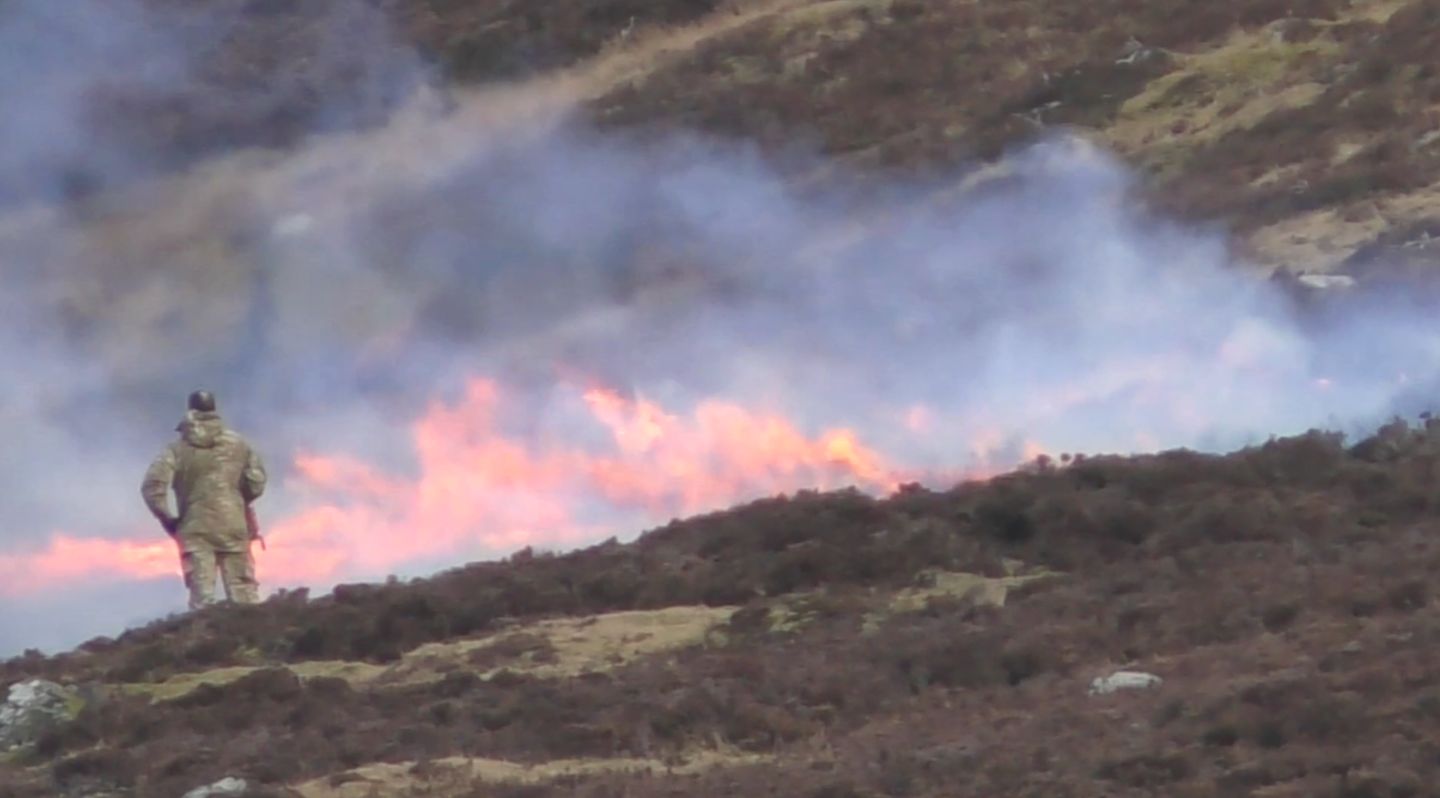Film footage of heather moorland on fire belching clouds of smoke across the Cairngorms has sparked fierce criticism of sporting estates.
Landowners and gamekeepers burn patches of heather to help boost populations of red grouse so there are more available to be shot by paying visitors.
But the practice, known as muirburn, is under attack by campaigners who say that it puts wildlife in danger and causes pollution. It is “deliberate environmental vandalism” and should cease, they say.
In response gamekeepers have launched an angry counter-offensive, accusing campaigners of an “orchestrated attempt” to “smear legal management activity”. Landowners insisted muirburn was beneficial and “strictly regulated”.
The Scottish Government is currently reviewing the way grouse moors are managed, with an independent group due to report “later in the spring”. Options for regulation, including the licensing of sporting estates, are said to be under consideration.
Film clips showing flames leaping from heather-clad hillsides have been released by Revive, a new coalition of groups campaigning for grouse moor reform. The clips are said to show “parts of the Cairngorms” and were apparently filmed in February.
Gamekeepers can be seen standing by the fires, with all-terrain vehicles. Large clouds of smoke are shown billowing long distances across moorlands.
Grouse thrive in upland areas where there is a varied patchwork of heather, with tall plants giving protection from predators and shorter plants providing food. Muirburn aims to regularly remove taller woody patches to allow for new growth to create diverse, grouse-friendly habitat.
But according to Revive, the practice is “hugely detrimental” to the environment. “The footage that we captured is extremely disturbing,” said Revive campaigner, Max Wiszniewski.
“Vast swathes” of heather were being set on fire “all for the single purpose of protecting grouse which will subsequently be shot for entertainment,” he argued.
“The public will be shocked to see the damage which is deliberately inflicted on our uplands to create a habitat suitable for one species to the detriment of our environment and wildlife.”
It is also claimed the clips show mountain hares running from the fires and the “devastating impact” muirburn can have on wildlife. “To witness wild animals running for their lives to escape such wilful and deliberate environmental vandalism is extremely upsetting,” said Robbie Marsland, director of the League Against Cruel Sports Scotland.
There was a “complete lack of justification” for the burning which put hares and ground-nesting birds at extensive risk, he contended. “And all for nothing more than to line the pockets of landowners looking to enrich their stocks of game birds for paying guns.”
Friends of the Earth Scotland pointed out that the peat beneath the heather was a huge store of climate-wrecking carbon. “We’re growing increasingly concerned about the extent and intensity of burning on grouse moors,” said the environmental group’s director, Dr Richard Dixon.
Damaging peat bogs by burning could cause carbon to be released and cause climate change, he argued. “There is more carbon locked up in Scotland’s peaty soils than in all the trees and vegetation in the whole of the UK,” he added.
“Urgent action is needed to reduce Scottish climate emissions and lock stored carbon into our environment. The Scottish Government must put in place plans to reverse the damaging environmental effects of moorland burning and protect our peatlands as the huge natural treasure they are.”
Revive’s campaign was backed by the Scottish Green MSP, Andy Wightman. “Muir-burning is an outdated and environmentally destructive activity that has little justification,” he said.
“Its use as part of the intensive management of land for grouse moor management should end.”
But the release of the film footage provoked a strong attack by the Scottish Gamekeepers Association. “This is another orchestrated attempt by a group desperately seeking legitimacy to smear legal management activity,” the association’s spokesman told The Ferret.
Muirburn “has been scientifically proven to provide many benefits for red grouse, black grouse, deer and sheep and to prevent more devastating moorland wildfires – like the recent one at Saddleworth – through the creation of vital fire-breaks,” he added.
He accused Revive of having previously made “unsubstantiated claims” about how many birds of prey went missing on grouse moors. “This week it is an attempt to manufacture an emotive message out of legal moorland habitat management,” the association spokesman said.
“Their ultimate aim is to ban grouse shooting and to put rural working families on the dole so we are not surprised at all by the extreme tactics.”
According to Scottish Land and Estates, which represents landowners, muirburn had been practiced for centuries and gave Scotland its famous purple heather landscapes. “Muirburn is strictly regulated, and its benefits are recognised by the government,” said the group’s Tim Baynes.
“At this time of year, old moorland vegetation is burnt off to enable fresh heather to grow. The mosaic habitat resulting from muirburn has also given us an extraordinary suite of rare birds and mammals which is the envy of other countries.”
Muirburn is very visible and the amount of smoke from small fires can be “deceptive,” he added. “The public should not be alarmed by the sight of smoke on the hills and there is a very clear code of practice that clearly states that all burning should be carried out carefully and responsibly.”
Baynes stressed that it was important to understand the exact circumstances of fires rather than simply calling for them to be stopped.
Careful muirburn had “minimal impact” on the peat below, he argued. “It can actually be beneficial because the charcoal formed by burning is a stable form of carbon storage, helping to prevent it being released into the atmosphere.”
The Game and Wildlife Conservation Trust, which researches moorland management for shooting estates, pointed out that muirburn was a “traditional and permitted” tool.
“It stimulates growth of globally rare moorland plant species such as heather and blueberry, benefiting sheep, deer, mountain hare, grouse, golden plover, and the blueberry bumblebee amongst others,” said a trust spokesperson.
“Increasingly research and best practice rejects the simplistic, inaccurate messages of some bodies that fire results in net carbon loss over the lifespan of the fire. Muirburn is even endorsed by researchers across the UK as a means to prevent even more damaging unmanaged wildfires.”
Heather burning is governed by the law and the Scottish Government’s 2017 Muirburn Code, the trust spokesperson added. “Following the law and these comprehensive guidelines will prevent damage to sensitive habitats, ecosystems and reduce the risk of uncontrolled wildfire.”
The Scottish Government set up an independent review group chaired by Professor Alan Werritty in 2017. It was examining “the impact of grouse moor management practices such as muirburn, and is due to report later in the spring,” said a government spokesman.
In the meantime the Muirburn Code “aims to ensure that when muirburn is carried out, it is in the right place, avoids damage to sensitive habitats and ecosystem services and doesn’t lead to wildfire,” he added.
“The code deals specifically with how to ensure peatland is not damaged by muirburn. While we are not aware of any recent instances of the code not being complied with, anyone concerned about a potential breach should contact the police.”
Cover photo and film footage thanks to Revive. Other photo thanks to Alan O’Dowd via this Creative Commons Licence. This story was published in tandem with the Sunday National.














